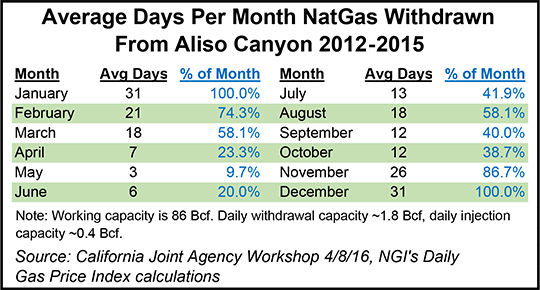Infrastructure | Markets | NGI All News Access | Regulatory
SoCalGas Storage Well Leak Costs Could Hit $665M; ‘Teachable Moment,’ Execs Say
In separate forums this week, senior executives of Sempra Energy and its Southern California Gas Co. (SoCalGas) utility began to deconstruct the unprecedented four-month natural gas storage well leak, which was sealed in mid-February, as underscoring the criticality of close electric-gas grid coordination and the heavily populated region’s energy reliability.

They made these observations as SoCalGas was estimating that by early June the total costs of responding to the leak at the 3,600-acre Aliso Canyon underground storage facility could total $665 million. Sempra CEO Debra Reed said that insurance will cover up to $650 million, speaking on a 1Q2016 earnings conference call last Wednesday.
On Thursday at an alternative transportation fuels conference in Long Beach, SoCalGas CEO Dennis Arriola called the Aliso incident “unfortunate and unusual,” but he added that his gas-only utility, the nation’s largest, is “all about learning and improving.” When it occurred the calamity drove thousands of residents from their homes in the nearby upscale Porter Ranch section of the suburban San Fernando Valley in the far northern end of Los Angeles.
“Whatever we learn from the ongoing investigation, we will make public, including the rest of the gas industry, because we want to make sure this type of incident never happens again,” Arriola said in a keynote address to the Alternative Clean Transportation (ACT) Expo.
Arriola said “what is coming out of this incidence is the importance natural gas plays, not just in heating homes and providing hot water, but also the interdependence between natural gas and electricity. I think that is something we have not done a good enough job in educating the public and policymakers about.
The absence of the key storage field, which is expected to be out of service through most of the summer, added to forecasts of a hot summer and a rapidly deteriorating hydro reserve has driven California forward prices for natural gas higher over the last month (see Daily GPI, May 5).
“Now that our storage facility is out of operation for a while, people realize that natural gas is integral in supplying safe, secure and reliable energy to this region.”
Separately on Wednesday, the California Independent System Operator (CAISO) board approved the power grid operator’s plan for enhanced gas-electric coordination to reduce the risk of electricity delivery issues tied to Aliso Canyon’s closure. “The plan is aimed at better aligning CAISO wholesale power markets with current conditions on the natural gas system in Southern California,” a spokesperson for the grid operator said.
At the beginning of May, state legislation to tighten the rules for gas storage wells (SB 380) was passed by the lower house Assembly and sent back to the Senate for concurrence, so it could be going to the governor soon. SB 380 essentially proposes to codify what the state Division of Oil, Gas and Geothermal Resources (DOGGR) has already implemented in the wake of Aliso Canyon’s situation (see Daily GPI, March 29). After staying neutral, SoCalGas said last Monday it supports the requirements for more comprehensive safety reviews.
“SoCalGas strongly supports efforts to enhance the safety of all gas storage facilities at both the state level as well as national, and we are supportive of forward-looking laws and regulations that adopt best practices for our storage facilities,” a SoCalGas spokesperson said.
While the results of the root cause of the prolonged leak will not be known before the end of the year and perhaps into next year, the legislative and litigation activity continues unabated. Although several state and local agencies have declared air quality is back to normal in the Porter Ranch residential community, county attorneys have gotten a state Superior Court judge in Los Angeles to require SoCalGas to keep paying the housing and commuting expenses of families who still refuse to move back home.
The latest deadline set by the court is June 7, and SoCalGas is still paying, albeit smaller overall amounts, for the remaining dislodged families. Last month a court hearing on the combined lawsuits filed against the Sempra Energy gas utility drew 80 attorneys representing 73 separate law firms and thousands of plaintiffs in 131 separately filed legal actions.
Of the projected $665 million in overall costs, Arriola told analysts on the Sempra earnings conference call that 70% is attributable to the residents’ relocation program; another 15% represents the cost of stopping the leak, and the rest (15%) is to respond so far to all of the litigation.
Arriola also said that there is a full court press by the state, independent investigators and SoCalGas to complete the detailed six-part testing and verification of all 114 storage wells at the 86 Bcf capacity Aliso Canyon facility. He expects the facility to be back in operation by late August. To date, 100 storage wells have completed the first of three phases in the six-part testing sequence.
“It’s really clear that the regulators and policymakers truly understand the importance of Aliso Canyon to both gas storage and electricity reliability, so the tone is let’s make sure it’s safe, but let’s get it up and running as quickly as we can,” Arriola said.
© 2024 Natural Gas Intelligence. All rights reserved.
ISSN © 1532-1231 | ISSN © 2577-9877 |
